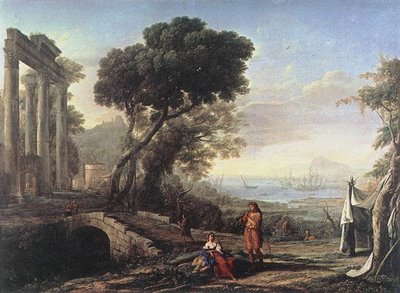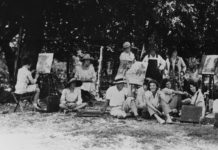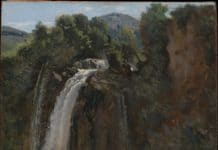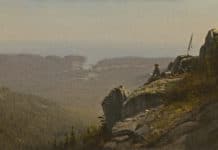The History of Plein Air Painting
 Before the 19th century, landscape painting was used as the basis for allegorical and narrative themes. The landscape was idealized. Jacob van Ruysdael and Claude Lorrain captured effects of perspective and atmosphere. However, their paintings were composed much as a set designer would create a backdrop for a theater production. For these artists, outdoor painting was confined to sketches or preliminary studies for reference.
Before the 19th century, landscape painting was used as the basis for allegorical and narrative themes. The landscape was idealized. Jacob van Ruysdael and Claude Lorrain captured effects of perspective and atmosphere. However, their paintings were composed much as a set designer would create a backdrop for a theater production. For these artists, outdoor painting was confined to sketches or preliminary studies for reference.
Outdoor painting has a relatively short history when measured against the great span of art across the centuries. It was not until the early 1800s that artists rejected the contrived landscapes of their predecessors and turned to nature for their inspiration. It was a small group of Englishmen, most notably John Constable and Joseph William Mallord Turner, who first produced finished works direct from nature. In 1824, John Constable’s paintings View on the Stour (1819) and The Hay Wain (1821) were exhibited at the prestigious Salon in Paris, winning gold medals. These works had a profound influence on the course of landscape painting in the 19th century. In France, Jean Batiste Camille Corot also painted scenes forgoing romanticized views.
 EARLY OUTDOOR MOVEMENTS
EARLY OUTDOOR MOVEMENTS
The Barbizon School
Began in France and flourished from 1830 to 1870. Members included Theodore Rousseau, Constant Troyon ,and Claude Daubigny.
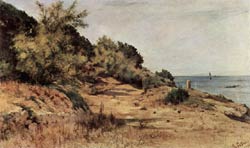 I Macchiaioli
I Macchiaioli
A group of painters in Tuscany from 1850 to 1900. Influenced by painters in France.
They rejected the academic romanticism of the time and turned to modern life for inspiration — again working directly from nature. Silvestro Lega, Giovanni Fattori, and Vincenzo Cabianca were some of the names in this group.
 The Impressionists
The Impressionists
The Barbizon School and I Macchiaioli helped form the great movement of the Impressionists. Beginning in France in the 1860s, with their first show in 1874, the Impressionists rejected the closed system of the academies. They embraced modern life as a theme. Claude Monet and Camille Pissarro were prominent figures in the group. The Impressionists sought to capture the effects of atmosphere, basing their art on the science of color and light. Most of their work was painted outdoors in a few hours’ time. For larger works, they would return to the same location, at the same time of day, and complete the painting.
The Hudson River School
1830s–1900s
 In America, the expansion in the West beckoned artists to paint these new lands. Collectors were eager to see the wilds of America through these paintings. The first and most notable painters in the Hudson River School were Thomas Cole and Asher Brown Durand.Following in their footsteps, were Frederick Edwin Church, Thomas Hill, Albert Bierstadt, and William Keith.
In America, the expansion in the West beckoned artists to paint these new lands. Collectors were eager to see the wilds of America through these paintings. The first and most notable painters in the Hudson River School were Thomas Cole and Asher Brown Durand.Following in their footsteps, were Frederick Edwin Church, Thomas Hill, Albert Bierstadt, and William Keith.
American Impressionism
1870s-1920s
The first American artists to embrace the new Impressionist style were John Joseph Enniking, Childe Hassam and Mary Cassatt. American Impressionism is a blend of academic training and Impressionist thought. This technique is recognized by more spontaneous brushwork and a lighter palette than the Hudson River School style. A few of the painters at the turn of the century defy categorization, John Singer Sargent and William Merritt Chase come to mind.
1920s-2000
 20th-century outdoor painters had a unique opportunity to choose whatever style they felt best reflected their beliefs about painting. Many fine painters worked through the middle of the century. Carl Rungius, Edgar Payne, and John Fabian Carlson are just a few. Contemporary Painters have discovered outdoor painting again. Building on the past, their commitment to works of quality has created a new golden age of painting.
20th-century outdoor painters had a unique opportunity to choose whatever style they felt best reflected their beliefs about painting. Many fine painters worked through the middle of the century. Carl Rungius, Edgar Payne, and John Fabian Carlson are just a few. Contemporary Painters have discovered outdoor painting again. Building on the past, their commitment to works of quality has created a new golden age of painting.
Printed with permission of Stephan Baumann, http://www.thegrandview.org

